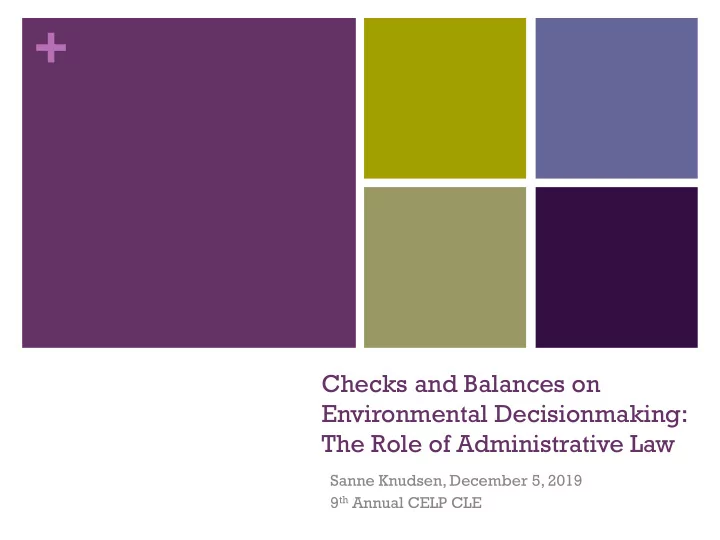

+ Checks and Balances on Environmental Decisionmaking: The Role of Administrative Law Sanne Knudsen, December 5, 2019 9 th Annual CELP CLE
+ An Abbreviated List of Regulatory Backsliding ◼ Power Plant Effluent Limits ◼ ACE Rule ◼ Repeal of Clean Water Rule ◼ Bears Ears National Monument ◼ Oil and Gas Emissions Standards ◼ Mercury and Air Toxics Rule ◼ Rescission of California Waiver
+ The Role of Courts: A Historical Perspective “[T]he courts no longer have the major role they once discharged in the direction formulation of the pertinent legal rules . . . . Primary responsibility has been vested in executive officials and independent regulatory agencies. But this is not to say that the courts do not have an important role. They have a role of review which has been of major significance. . . . [Judicial review] is conducted with an awareness that agencies and courts together constitute a ‘partnership in furtherance of the public interest’ and that the two are collaborative instrumentalities under which the ‘court is in a real sense part of the total administrative process, and not a hostile stranger to the office of first instance .’” Harold Leventhal , Environmental Decision-Making and the Role of the Courts , 122 U. Penn. L. Rev. 509 (1974)
+ Checking Environmental Decisions ◼ Engaging in legislative advocacy ◼ Participating in the regulatory process ◼ Petitions for rulemaking (e.g. Mass v. EPA) ◼ Commenting on proposed rules (building the administrative record) ◼ Seeking judicial review ◼ Citizen-suits to enforce statutory mandates ◼ Common law or constitutionally based causes of action ◼ Challenging agency decision-making through APA suits Key Changes to Agency Patterns of Success Taxonomy of Deference Doctrines in Recent APA APA Suits (Kisor v. Wilkie) Challenges
A Taxonomy of APA Suits APA Organic Acts Cases Types of Challenges Substantive Substantive Procedural Challenges To Challenges To Challenges Agency Inaction Agency Action De Novo Legal (706(2)(D)) Reasoning Factual Authority / Policy Basis Issues Arbitrary & Substantial Evidence Chevron/ Capricious (706(2)(E)) or Arbitrary Auer/ 5 (706(2)(A) & Capricious (706(2)(A)) Skidmore
Review of Legal Authority Types of Challenges Substantive Challenges To Agency Action Legal Authority Issues Agency If neither Chevron Agency interpretation of interpretation of nor Auer, then statute (Chevron) 6 regulation (Auer) Skidmore.
+ Agency interpretation of own regs: Before Kisor v. Wilkie ◼ Origins of Auer Deference ◼ Seminole Rock v. Bowles (1945) ◼ Historical Application ◼ Presumptive deference: ◼ Agency interpretations of their own regulations are given “controlling weight unless [that interpretation is plainly erroneous.” ◼ Context-neutral ◼ Auer deferred to an interpretation offered for the first time in an agency’s amicus brief ◼ Criticisms Leading Up to Kisor ◼ Separation of powers concerns ◼ Risk for abuse ◼ Notice concerns
Talk America (2011) + “[W]hile I have in the past uncritically accepted [Auer], I have become increasingly doubtful of its validity.” — Scalia, J., concurring
+ Christopher v. SmithKline Beecham (2012) “Our practice of deferring to an agency’s interpretation of its own ambiguous regulations undoubtedly has important advantages, but this practice also creates a risk that agencies will promulgate vague and open-ended regulations that they can later interpret as they see fit, thereby ‘ frustrat[ing] the notice and predictability purposes of rulemaking.””
NEDC v. Decker (2013) + “Questions of Seminole Rock and Auer deference arise as a matter of course on a regular basis. The bar is now aware that there is some interest in reconsidering those cases, . . . .” — Roberts, C.J., concurring
+ Key Changes to Agency Deference: Kisor v. Wilkie Is the regulation ambiguous? If genuinely ambiguous, is the agency interpretation reasonable? Does the character and context of the agency interpretation entitle the interpretation to controlling weight?
+ Key Changes to Agency Deference: Post Kisor v. Wilkie Defer after engaging in rigorous review. See, e.g., Am. Tunaboat Ass'n v. Ross, 391 F. Supp. 3d 98 (D.D.C. 2019) Declining to defer because “the 79 absence of genuine ambiguity in the rule’s meaning precludes us from deferring to DOE’s contrary interpretation. “ NRDC v. Perry, 940 F.3d 1072 (9th Cir. 2019) Declining to defer because the regulation is unambiguous after “exhausting all the traditional tools of construction” (and yet agreeing with the agency). Stand Up for California! v. DOI (D.D.C. Oct. 7, 2019)
+ Key Changes to Agency Deference: Post Kisor v. Wilkie Hawaii Wildlife Fund v. County of Maui Oral Arguments Heard Nov. 6, 2019 Photo credit: https://earthjustice.org/features/
+ Patterns of Success
+ Thank you!
Recommend
More recommend